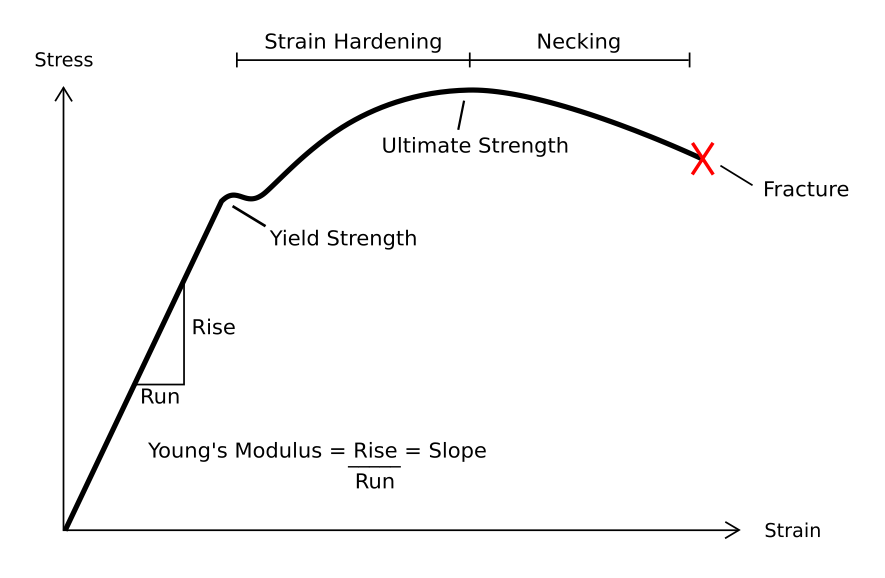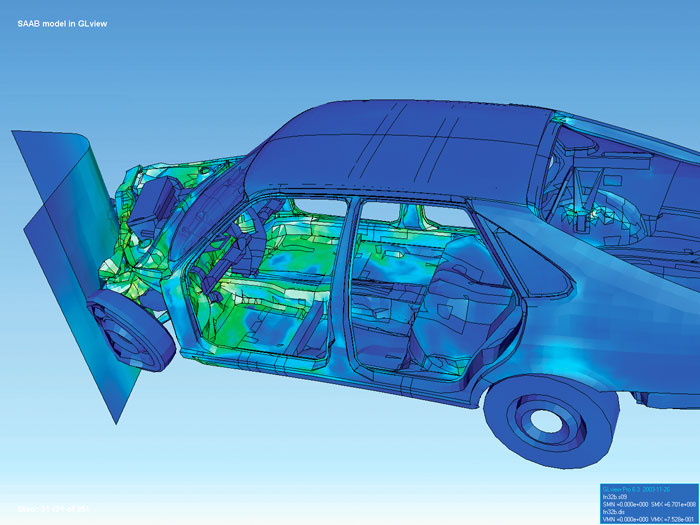|
Neo-Hookean Solid
A neo-Hookean solid is a hyperelastic material model, similar to Hooke's law, that can be used for predicting the nonlinear stress–strain behavior of materials undergoing large deformations. The model was proposed by Ronald Rivlin in 1948 using invariants, though Mooney had already described a version in stretch form in 1940, and Wall had noted the equivalence in shear with the Hooke model in 1942. In contrast to linear elastic materials, the stress–strain curve of a neo-Hookean material is not linear. Instead, the relationship between applied stress and strain is initially linear, but at a certain point the stress–strain curve will plateau. The neo-Hookean model does not account for the dissipative release of energy as heat while straining the material, and perfect elasticity is assumed at all stages of deformation. In addition to being used to model physical materials, the stability and highly non-linear behaviour under compression has made neo-Hookean materials a po ... [...More Info...] [...Related Items...] OR: [Wikipedia] [Google] [Baidu] |
Solid Mechanics
Solid mechanics (also known as mechanics of solids) is the branch of continuum mechanics that studies the behavior of solid materials, especially their motion and deformation (mechanics), deformation under the action of forces, temperature changes, phase (chemistry), phase changes, and other external or internal agents. Solid mechanics is fundamental for civil engineering, civil, Aerospace engineering, aerospace, nuclear engineering, nuclear, Biomedical engineering, biomedical and mechanical engineering, for geology, and for many branches of physics and chemistry such as materials science. It has specific applications in many other areas, such as understanding the anatomy of living beings, and the design of dental prosthesis, dental prostheses and surgical implants. One of the most common practical applications of solid mechanics is the Euler–Bernoulli beam theory, Euler–Bernoulli beam equation. Solid mechanics extensively uses tensors to describe stresses, strains, and the r ... [...More Info...] [...Related Items...] OR: [Wikipedia] [Google] [Baidu] |
Finite Strain Theory
In continuum mechanics, the finite strain theory—also called large strain theory, or large deformation theory—deals with deformations in which strains and/or rotations are large enough to invalidate assumptions inherent in infinitesimal strain theory. In this case, the undeformed and deformed configurations of the continuum are significantly different, requiring a clear distinction between them. This is commonly the case with elastomers, plastically deforming materials and other fluids and biological soft tissue. Displacement field Deformation gradient tensor The deformation gradient tensor \mathbf F(\mathbf X,t) = F_ \mathbf e_j \otimes \mathbf I_K is related to both the reference and current configuration, as seen by the unit vectors \mathbf e_j and \mathbf I_K\,\!, therefore it is a '' two-point tensor''. Two types of deformation gradient tensor may be defined. Due to the assumption of continuity of \chi(\mathbf X,t)\,\!, \mathbf F has the inverse \mathbf H = \ma ... [...More Info...] [...Related Items...] OR: [Wikipedia] [Google] [Baidu] |
Engineering Stress
In engineering, deformation (the change in size or shape of an object) may be ''elastic'' or ''plastic''. If the deformation is negligible, the object is said to be ''rigid''. Main concepts Occurrence of deformation in engineering applications is based on the following background concepts: * ''Displacements'' are any change in position of a point on the object, including whole-body translations and rotations ( rigid transformations). * ''Deformation'' are changes in the relative position between internals points on the object, excluding rigid transformations, causing the body to change shape or size. * ''Strain'' is the ''relative'' ''internal'' deformation, the dimensionless change in shape of an infinitesimal cube of material relative to a reference configuration. Mechanical strains are caused by mechanical stress, ''see stress-strain curve''. The relationship between stress and strain is generally linear and reversible up until the yield point and the deformation is ... [...More Info...] [...Related Items...] OR: [Wikipedia] [Google] [Baidu] |
Newton–Raphson
In numerical analysis, the Newton–Raphson method, also known simply as Newton's method, named after Isaac Newton and Joseph Raphson, is a root-finding algorithm which produces successively better approximations to the roots (or zeroes) of a real-valued function. The most basic version starts with a real-valued function , its derivative , and an initial guess for a root of . If satisfies certain assumptions and the initial guess is close, then x_ = x_0 - \frac is a better approximation of the root than . Geometrically, is the x-intercept of the tangent of the graph of at : that is, the improved guess, , is the unique root of the linear approximation of at the initial guess, . The process is repeated as x_ = x_n - \frac until a sufficiently precise value is reached. The number of correct digits roughly doubles with each step. This algorithm is first in the class of Householder's methods, and was succeeded by Halley's method. The method can also be extended to comp ... [...More Info...] [...Related Items...] OR: [Wikipedia] [Google] [Baidu] |
Pressure
Pressure (symbol: ''p'' or ''P'') is the force applied perpendicular to the surface of an object per unit area over which that force is distributed. Gauge pressure (also spelled ''gage'' pressure)The preferred spelling varies by country and even by industry. Further, both spellings are often used ''within'' a particular industry or country. Industries in British English-speaking countries typically use the "gauge" spelling. is the pressure relative to the ambient pressure. Various #Units, units are used to express pressure. Some of these derive from a unit of force divided by a unit of area; the International System of Units, SI unit of pressure, the Pascal (unit), pascal (Pa), for example, is one newton (unit), newton per square metre (N/m2); similarly, the Pound (force), pound-force per square inch (Pound per square inch, psi, symbol lbf/in2) is the traditional unit of pressure in the imperial units, imperial and United States customary units, US customary systems. Pressure ma ... [...More Info...] [...Related Items...] OR: [Wikipedia] [Google] [Baidu] |
Isochoric
Isochoric may refer to: *cell-transitive, in geometry *isochoric process In thermodynamics, an isochoric process, also called a constant-volume process, an isovolumetric process, or an isometric process, is a thermodynamic process during which the volume of the closed system undergoing such a process remains constant ..., a constant volume process in chemistry or thermodynamics * Isochoric model {{Disambiguation ... [...More Info...] [...Related Items...] OR: [Wikipedia] [Google] [Baidu] |
Stress (physics)
In continuum mechanics, stress is a physical quantity that describes Force, forces present during Deformation (physics), deformation. For example, an object being pulled apart, such as a stretched elastic band, is subject to Tension (physics), ''tensile'' stress and may undergo Elongation (materials science), elongation. An object being pushed together, such as a crumpled sponge, is subject to Compression (physics), ''compressive'' stress and may undergo shortening. The greater the force and the smaller the cross-sectional area of the body on which it acts, the greater the stress. Stress has Dimension (physics), dimension of force per area, with SI Units, SI units of newtons per square meter (N/m2) or Pascal (unit), pascal (Pa). Stress expresses the internal forces that neighbouring particles of a continuous material exert on each other, while Strain (mechanics), ''strain'' is the measure of the relative deformation (mechanics), deformation of the material. For example, when a ... [...More Info...] [...Related Items...] OR: [Wikipedia] [Google] [Baidu] |
Abaqus
Abaqus FEA (formerly ABAQUS) is a software suite for finite element analysis and computer-aided engineering, originally released in 1978. The name and logo of this software are based on the abacus calculation tool. The Abaqus product suite consists of five core software products: # ''Abaqus/CAE'', or "Complete Abaqus Environment" (a backronym with a root in Computer-Aided Engineering). It is a software application used for both the modeling and analysis of mechanical components and assemblies (pre-processing) and visualizing the finite element analysis result. A subset of Abaqus/CAE including only the post-processing module can be launched independently in the ''Abaqus/Viewer'' product. # ''Abaqus/Standard'', a general-purpose Finite-Element analyzer that employs implicit integration scheme (traditional). # ''Abaqus/Explicit'', a special-purpose Finite-Element analyzer that employs explicit integration scheme to solve highly nonlinear systems with many complex contacts under tra ... [...More Info...] [...Related Items...] OR: [Wikipedia] [Google] [Baidu] |
Finite Element Analysis
Finite element method (FEM) is a popular method for numerically solving differential equations arising in engineering and mathematical models, mathematical modeling. Typical problem areas of interest include the traditional fields of structural analysis, heat transfer, fluid flow, mass transport, and electromagnetic potential. Computers are usually used to perform the calculations required. With high-speed supercomputers, better solutions can be achieved and are often required to solve the largest and most complex problems. FEM is a general numerical analysis, numerical method for solving partial differential equations in two- or three-space variables (i.e., some boundary value problems). There are also studies about using FEM to solve high-dimensional problems. To solve a problem, FEM subdivides a large system into smaller, simpler parts called finite elements. This is achieved by a particular space discretization in the space dimensions, which is implemented by the constructio ... [...More Info...] [...Related Items...] OR: [Wikipedia] [Google] [Baidu] |
Lamé Parameters
In continuum mechanics, Lamé parameters (also called the Lamé coefficients, Lamé constants or Lamé moduli) are two material-dependent quantities denoted by ''λ'' and ''μ'' that arise in strain- stress relationships. In general, ''λ'' and ''μ'' are individually referred to as ''Lamé's first parameter'' and ''Lamé's second parameter'', respectively. Other names are sometimes employed for one or both parameters, depending on context. For example, the parameter ''μ'' is referred to in fluid dynamics as the dynamic viscosity of a fluid (not expressed in the same units); whereas in the context of elasticity, ''μ'' is called the shear modulus, and is sometimes denoted by ''G'' instead of ''μ''. Typically the notation ''G'' is seen paired with the use of Young's modulus ''E'', and the notation ''μ'' is paired with the use of ''λ''. In homogeneous and isotropic materials, these define Hooke's law in 3D, \boldsymbol = 2\mu \boldsymbol + \lambda \; \operatorname(\boldsymbo ... [...More Info...] [...Related Items...] OR: [Wikipedia] [Google] [Baidu] |




